Posted in category "Popes"
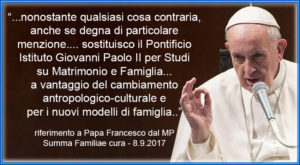
Pope Francis has overhauled the Vatican institute most closely associated with the conservative sexual morals promoted by St. John Paul II, saying it was necessary to adapt and expand its mission to address the reality of today’s Catholics.
Officials said the revamped John Paul II Theological Institute for the Marriage and Family Sciences will offer degrees in the social sciences — such as sociology, anthropology, psychology — as well as biology and other sciences, reflecting a vision of the family that goes well beyond strict Catholic theology.
The inclusion of biological sciences in the curriculum, and a mission statement that cites a focus on human “regeneration” and care for the planet, suggests that the revamped institute will address human sexuality, the environment and the church’s position on artificial contraception.
With a motu proprio issued on September 19, 2017, Pope Francis closed the Vatican institute set up by St. Pope John Paul II to study marriage and family life, replacing it with a new institute with a different name and different focus.
The papal document, Summa Familiae Cura, formally ends the work that started in 1981 as the Pontifical John Paul II Institute for Studies on Marriage and the Family. In its place the motu proprio establishes the Pontifical John Paul II Theological Institute for Marriage and Family Sciences.
The new institute is intended to take a different approach to the study of family life. It will reflect the work of the two recent Synod meetings and the Pope’s own apostolic exhoration, Amoris Laetitia.
In Summa Familiae Cura the Pope emphasized the Church must respond to the needs of troubled families, and couples struggling with the marriages, in a society that no longer supports the traditional Christian understanding of marriage. Pope Francis also stressed the need for the Church to incorporate the perspectives of contemporary science in analyzing family life.
While praising the vision of his predecessor, Pope Francis says that the revision of the Institute is a response to “the new pastoral challenges to which the Christian community is called to respond.” He writes: “Anthropological-cultural change, that today influences all aspects of life and requires an analytic and diversified approach, does not permit us to limit ourselves to practices in pastoral ministry and mission that reflect forms and models of the past.”
Archbishop Vincenzo Paglia, who is the chancellor of the new Institute, told Vatican Radio that a key focus of its work would be “dialogue with all the human sciences, because family today rediscovers its vocation, not in the abstract.”
A sampling of views from the Peanut Gallery:
“Sexual morals as promoted by St. John Paul II? BAHAHAHAHAHA! The biggest pedophile protector ever. First, he has Bernard Law brought to the Vatican to escape prosecution for transferring countless pedophile priests, then he claimed to be best friends and even traveled around with Maciel, the founder of the Legionnaires of Christ, and one of the most notorious pedophiles himself, along with seducing anything he could get his hands on.” – Bill
“Fortunately we will not have to suffer this man much longer. Natural catastrophes daily say it all as to how close we are to Judgement.” – JD
“Wrong, wrong! St. Pope John Paul II had it right. This liberal Jesuit is splitting the Church. It will not work. Many world Catholics are angry and confused. Francis must abide by the Bible and Catholic theology all of which is the word of Christ.” – toughcritic
“With Francis, it’s always the same message: disruption and discontinuity.” – dover beachcomber
“It’s really tough to be optimistic on this for three reasons: 1) Nothing was broke so don’t “fix” it. 2) The (shudder) language used in “justifying” the change. 3) the “shudder” emphasis on Amoris Laetitia. Speaking of which, what happened to our 4 stalwarts?” – jalsardl5053
“The Church (needs) to incorporate the perspectives of contemporary science in analyzing family life.” This sounds to me very-very suspicious. I hope, I’m wrong.” – feedback
“I supposed he is trying to make the church more relevant in the modern world but he is making it less relevant to me.” – Jerome
“That this institute will be run by Archbishop Vincenzo Paglia who favored homoerotic art for his Cathedral makes my skin crawl. Viewing his mural makes me want to go and take a bath. It is so bad I will not provide a link to it. Nothing good will come from this institute!” – Anonymous
My take: Pope Francis continues remaking the Church from a museum into a garden.
While most of the world is thrilled by Pope Francis, a few are not. One of the most outspoken is Raymond Cardinal Burke, 66. 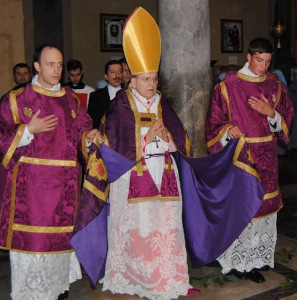
Cardinal Burke is a voice of conservatism in the Roman Catholic Church and American politics, and a prominent devotee of the Tridentine Mass. He is intent on the “reform of the reform” of Vatican II.
Many photos of Cardinal Burke feature him in full regalia, a billowing cappa magna, lace rochet, velvet gauntlets, a towering mitre–the image of royalty, privilege and authority is unmistakable. That style is the polar opposite of Pope Francis, who is urging clerics to be pastors who “smell like their sheep.” 
Over the last year and a half Cardinal Burke has made a series of statements to the press challenging Pope Francis’ shift in pastoral style. In an interview with the Spanish Catholic weekly Vida Nueva, published on October 30, 2014, Burke insisted he was not speaking out against the pope personally but raising concern about his leadership.
“Many have expressed their concerns to me. At this very critical moment, there is a strong sense that the church is like a ship without a rudder,” Burke said. “Now, it is more important than ever to examine our faith, have a healthy spiritual leader and give powerful witness to the faith.” 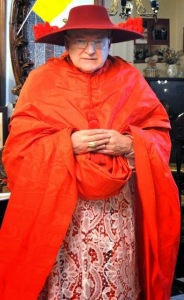
The “rudderless ship” remark was probably the last straw in a string of provocative challenges from Cardinal Burke. On November 8, 2014 he was officially removed as head of the Vatican’s highest judicial authority, known as the Supreme Tribunal of the Apostolic Signatura. Obviously, he didn’t get the hint after he was dropped from the Congregation of Bishops in December 2013. Cardinal Burke no longer holds any influential Vatican posts. 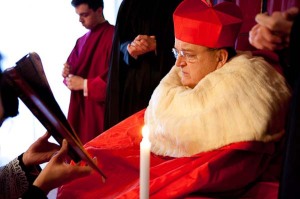
At the same time, his appointment as Patron of the Sovereign Military Order of Malta was announced. The Knights of Malta were founded in 1048 and recognized as a lay religious order by Pope Paschal II in 1113. It has a very elaborate hierarchy, with religious at the top, nobles next, and larger groups of knights and dames of common birth below them in their own separate categories and classes. Each group has its own insignia, making the classes of persons easily recognizable.
Pope Francis has done Cardinal Burke a favor. He will have ample opportunity to wear the finery he enjoys and not raise an eyebrow. The people around him will be dressed in equally rich, dramatic and historically meaningful capes and crosses. He will also feel at home with people who are used to looking backward to the Middle Ages. 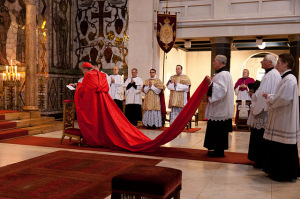
On September 25, 2014, Pope Francis removed Bishop Rogelio Ricardo Livieres Plano, 69, head of the Diocese of Ciudad del Este, the second largest city in Paraguay. He took the action to preserve the “unity” of both the bishops and the faithful” and “under the weight of serious pastoral concerns,” said the Vatican in a statement. 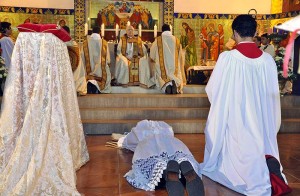
Bishop Livieres, a member of Opus Dei, repeatedly feuded with the other bishops in Paraguay over seminarian formation, liberation theology and pastoral tone.
He was appointed to the diocese by St. John Paul II in 2004 with a mandate, communicated to him by the papal nuncio at the time, to oppose Paraguayan bishops’ “monolithic” support for liberation theology. He said Pope Benedict XVI personally told him in 2008 that liberation theology was “the problem in all of Latin America.”
But Pope Benedict “had a very different orientation from the present pontificate,” the bishop said. “This is a pontificate opposed to the previous pontificate.”
Soon after he was installed, Bishop Livieres opened his own diocesan seminary in Ciudad del Este, marked by a more orthodox style then the main seminary in Paraguay’s capital, Asuncion.
The man he appointed as his Vicar General, a position often responsible for the oversight of clerical sexual abuse, is the Rev. Carlos Urrutigoity. Fr. Urrutigoity has been accused multiple times of sexual abuse of high school boys and seminarians in the guise of spiritual direction.
Fr. Urrutigoity has an interesting story of his own that mixes ultra orthodoxy with homo-erotic overtones and encounters. He began his clerical career in the schismatic Society of St. Pius X. 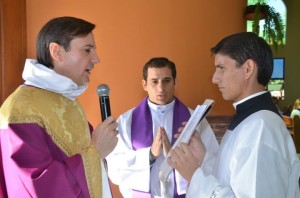
In 2002, Urrutigoity was accused of sexual abuse of young men in a highly publicized lawsuit in the diocese of Scranton, PA. He and another priest, Eric Ensey, were suspended by then-Bishop James Timlin amid allegations that they had sexually molested students at St. Gregory’s Academy, a high school for boys operated by the Priestly Fraternity for St. Peter, an order devoted to the Latin Mass. The diocese reached a $400,000 plus settlement in the case in 2006. St. Gregory’s Academy closed in 2012.
A statement on the Diocese of Scanton, PA website describes Fr. Urrutigoity as a “serious threat to young people” and says that Bishop Timlin’s immediate successor, Bishop Joseph Martino, cautioned Bishop Livieres against accepting Fr. Urrutigoity as an active priest.
“Bishop Martino…carefully and consistently expressed his grave doubts about this cleric’s suitability for priestly ministry and cautioned the bishop of the Diocese of Ciudad del Este, Paraguay, to not allow Father Urrutigoity to incardinate into his diocese,” the statement reads.
When the archbishop of Asuncion, Eustaquio Cuquejo Verga, asked Bishop Livieres to investigate Fr. Urrutigoity, Livieres fired back publicly saying, “I think Cuquejo is a homosexual” to Paraguayan TV station La Tele.
In July 2014, Pope Francis sent a cardinal and an archbishop to investigate the Ciudad del Este diocese. They were looking into accusations of embezzlement in the management of the diocese’s finances, severing ties with other bishops, and protecting and promoting Fr. Carlos Urrutigoity in the face of numerous warnings by other dioceses.
Shortly after the July 21-26 visit, the Vatican ordered Fr. Urrutigoity be removed from ministry, and severely restricted the activities of Bishop Livieres, including removing his authority to ordain priests.
Although the Vatican did not specify Bishop Livieres’ financial irregularities, he was allegedly accused of using funds destined for needy and abandoned children, single pregnant women, and women subject to domestic violence, to cover phone, gas and other expenses at the seminaries he opened.
Fr. Ciro Benedettni, deputy head of the Vatican press office, said issues surrounding Fr. Urrutigoity were part of the reason for the removal of Bishop Livieres, but the main motive was to put a stop to the infighting among Paraguayan bishops over the training of priests and the mismanagement of seminaries set up by Bishop Livieres.
The downfall of Bishop Livieres has several similarities to the case of Bishop Robert Finn of the Kansas City-St. Joseph, MO diocese:
-Both bishops are members of Opus Dei.
-Both were outspoken promoters of Catholic orthodoxy.
-Both protected priests credibly accused of sexual abuse.
Either something doesn’t add up morally, or priestly sexual peccadilloes count for much less than doctrinaire correctness to Catholic tradition.
Further Reading:
“Purgatory Begins for Bishop Finn”
“The Curious Case of Carlos Urrutigoity”
“Rogue Priest, formerly of the Diocese of Scanton, Living the Good Life in Paraguay”

In the summer of 1206, St. Francis went into the small chapel of San Damiano near Assisi to pray. As he knelt before the crucifix, he heard Jesus’ invitation: “Francis, go rebuild my Church, which you see is falling into ruins.” “Yes!” said Francis, “This is what I want; this is what I long for with all my heart.”
800 years later, the first Pope Francis took up the same challenge–to rebuild a Church that was in almost total disgrace, disarray, and irrelevant. The message of the Gospels had become lost to dogmatic meanness and nit-picking.
Inside the Jesuits: How Pope Francis is Changing the World and the Church by noted journalist and former Jesuit Robert Blair Kaiser, offers insights on the pope’s “Jesuit DNA.” It is this DNA that impels him with a “holy boldness” to push the boundaries to make the world a better place, and rebuild the Church to a house of mercy and humanity.
The Jesuit DNA includes several things: a striving for the greater glory of God (ad majorem Dei gloriam); but especially to go to the edges, the margins, to learn, understand and serve. After Vatican II, the author relates that most Jesuits call salvation “being all we can be in this life” and not simply to get to heaven, but to make a difference in the lives of other people.
Pope Francis’ emphasis on humanity vs. rules and regulations is changing the culture of judgement (abortion, same-sex marriage, doctrinaire fixation (“are you pure enough to call yourself ‘Catholic?’) to a culture of mercy and mission. He wants to be fully engaged with people, and is leading the Church to do likewise. He starts by calling himself a sinner who has made many mistakes (when was the last time we heard a cardinal, bishop, or priest do that?) and reminds us that Christ came to us so that we might know life more fully.
The author framed this motivation wonderfully by describing his own experience as a teacher and coach at Saint Ignatius Prep, a high school for boys in San Francisco, CA: “I was trying to show them that their religion, fully lived, was something that would make them more human, happier individuals, with a humanity and happiness that would bring joy to those around them. I wanted to destroy the image of religion as something that made people less human, less joyful, less real.”
The author doesn’t back away from the warts. He examines Pope Francis’ time as provincial of the Argentine Jesuits and as archbishop of Buenos Aires. He has come under criticism for both periods because of his lack of support for liberation theology, and for not standing up to the military junta that caused the death or disappearance of over 20,000 people.
The pope did not shy away from his record, but doesn’t go into specifics. He explains the Lord leads to a growth of knowledge through his faults and sins, and also that he made decisions alone and in the midst of an interior crisis. If experience leads to a conversion of heart, who are we to judge?
Robert Kaiser also raises the pope’s, Church’s, and Jesuits’ poor records and lack of engagement with women–half the Church. My good friend, theologian Dr. Mary E. Hunt, challenges the pope on this issue: “It is intellectually embarrassing to hear a man who is so conversant with music, literature and poetry have such a palty vocabulary when it comes to women. Thus far, Francis has not had any public conversation with a woman church leader of any sort. The continued oppression of U.S. women religious, officially approved by him, is a negative sign as well.”
The author thinks Dr. Hunt is mistaken, but I agree with her. The pope needs to address the impact of our closed, male-oriented institution on the poorest of the poor–Catholic women. Women continue to wait for meaningful action from Pope Francis. His Jesuit DNA won’t help us there–Jesuits have little to do with women’s issues or women as a group.
One surprise in the book for me was the suggestion that 46-year-old Jorge Bergoglio had been in love. In March 1986 he went to Frankfurt, Germany for two years to pursue a doctorate. In 1987 his provincial ordered him back to Argentina, his thesis only half finished. He was put on severe restrictions for correspondence and communication. This kind of discipline is only warranted if the man has told superiors he has fallen in love, or if a fellow Jesuit found out he is having a love affair.
Would love and separation make a person more emphathetic to its effects in other people’s lives? I think so. Perhaps this period in the pope’s life has led him to emphasize mercy, forgiveness and the human vs. ideological. Pope Francis has described himself as a sinner who has made hundreds of mistakes. It sounds like it’s true–not some stock piety.
About half the book is devoted to Pope Francis, the remainder is parables about fellow Jesuits and former Jesuits who illustrate the best of “Jesuit DNA.” Like Marines–once a Marine, always a Marine, Jesuits forever identify themselves as brothers, and retain their values, friendships and network for a lifetime.
The men profiled include Fr. Marie Joseph Pierre Teilhard de Chardin, a scientist and humanist; Fr. George Dunne, writer and social justice crusader; Bill Cain, playwright and screen writer; Fr. John Baumann, co-founder of PICO (Pacific Institute of Community Organizing); Governor Jerry Brown of California, John Dear, peace activist; and, of course, Inigo Lopez de Loyola, the founder of the Jesuits. There is a lot to inspire all of us in their generous lives.
When Jorge Bergoglio became Pope Francis people and pundits wondered what it would mean to have a Jesuit pope? How does he think? What is important to him? What can we expect?
On the way back to Rome from World Youth Day in Rio de Janeiro Pope Francis addressed this question by reporter Caroline Pigozzi from Paris Match:
“Good evening, Holy Father. I would like to know if you, since you’ve been Pope, still feel yourself a Jesuit?”
Pope Francis: “I feel myself a Jesuit in my spirituality, in the spirituality of the Exercises, spirituality, the one I have in my heart. But I feel so much like this that in three days I’ll go to celebrate with Jesuits the feast of Saint Ignatius: I will say the morning Mass. I haven’t changed my spirituality, no. Francis, Franciscan, no. I feel myself a Jesuit and I think like a Jesuit. Not hypocritically, but I think as a Jesuit. Thank you.”
My Rating: ***** Read this book if you are the type of person who likes to know the “why” behind people and events.
Inside the Jesuits: How Pope Francis is Changing the Church and the World.Published by Rowman and Littlefield, 2014. Available at Barnes and Noble, Amazon, and fine booksellers everywhere.
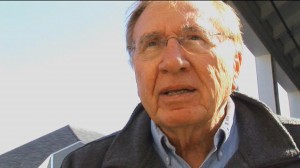
Author: Robert Blair Kaiser is an American author and journalist, best known for his writings on the Catholic Church. A former Jesuit, Kaiser left the Society of Jesus three years before his ordination to pursue a career in journalism. He served as an award-winning religion reporter for The New York Times, CBS News, Newsweek and Time. Throughout the Second Vatican Council, Kaiser was Time magazine’s reporter in Rome and the preeminent reporter on the Council in the English-speaking world. For his work on the Council, Kaiser won the Overseas Press Club Award for best foreign reporting on foreign affairs. He is the author of sixteen other books, including A Church in Search of Itself.

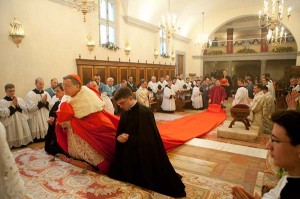
December 15, 2013: The week Pope Francis delivers a homily focusing on “A Church That Lacks Prophecy Becomes Filled with Clericalism,” is the same week that arch conservative Cardinal Raymond L. Burke was dumped off the Congregation for Bishops. He was replaced by Cardinal Donald Wuerl of Washington, DC, a moderate.
An amazing coinkydink? I don’t think so.
In his homily Pope Francis described the role of the prophet as one who carries within themselves three moments: the promise of the past, contemplation of the present and courage to show the path toward the future. The pope stressed the words of prophets are necessary, although many times they are rejected.
“When there is no prophecy in the people of God,” said Francis, “the void it leaves becomes occupied with clericalism. And it is this clericalism that Jesus asks, ‘With what authority do you do this? With what authority?’ And the memory of the promise and the hope of going forward becomes reduced to only the present: neither the past nor a hopeful future. The present is legal. If it is legal it goes forward,” the pope said.
Concluding his homily, Pope Francis prayed that in these days leading to Christmas, that there may not be a lack of prophets: “Let us not tire of moving forward! Let us not be closed in the legality that closes doors! Lord, free your people from the spirit of clericalism and help them with the spirit of prophecy.”
Amen!
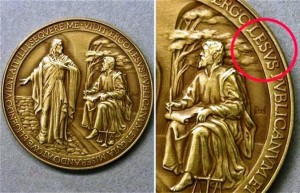
The Vatican had to withdraw more than 6,000 medallions minted to commemorate the beginning of Pope Francis’ papacy because of a spelling mistake.
Jesus was misspelled as “Lesus.” The Latin inscription should have been “Iesus” since the letter “J” is not used in Latin.
The phrase reads on the Vatican website: “Vidit ergo Jesus publicanum, et quia miserando atque eligendo vidit, ait illi, ‘Sequere me'” or “Jesus therefore sees the tax collector, and since he sees by having mercy and by choosing, he says to him, ‘follow me.'”
The inscription is Francis’ papal motto, taken from a meditation by the 8th century English monk, the Venerable Bede, on a passage of the Gospel in which Jesus calls St. Matthew, a tax collector, to become an apostle.
The Vatican said the Latin phrase profoundly affected the future Pope Francis at age 17 when he heard God calling him to the priesthood. In his native Argentina and in his nascent papacy, Francis has made a point of preaching mercy, and reaching out to people on the margins of society.
The medallions, which went on sale on October 8, 2013 had to be pulled from circulation after the spelling error was belatedly discovered. Four of the coins had been sold. They are now worth a mint.
This has been a stunner of a week. I’m still reeling.
It started with the closing of World Youth Day 2013 in Rio de Janeiro, Brasil, where Pope Francis’ closing Mass on Copacabana beach drew an estimated three million participants. Many of them were enthusiastic young people. He encouraged them to go home and shake things up, “make a mess.”
He set the first example.
On a plane back to Rome from his triumphant trip to Rio, Pope Francis chatted with journalists for over an hour. There were no handlers or intermediaries, just plain-spoken remarks. 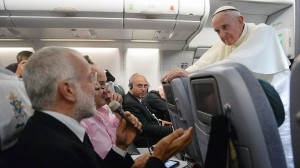
He was asked about gay priests and gay Catholics.
Gay people should be integrated into society instead of ostracized, Pope Francis told journalists. Answering a question about reports of homosexuals in the clergy, the pope answered, “If someone is gay and he searches for the Lord and has good will, who am I to judge?”
One question centered on recent reports in Italian media that accused the Vatican Bank’s Monsignor Battista Ricca of having an affair with a Swiss Army captain. In response, Francis said he looked into the reports but found nothing to support the allegations.
The pope also used the occasion to expand on his June remarks about a “gay lobby” in the Vatican, clarifying that “he was against all lobbies, not just gay ones,” the Italian news agency reports.
“Being gay is a tendency. The problem is the lobby,” ANSA quotes the pontiff saying. “The lobby is unacceptable, the gay one, the political one, the Masonic one.”
The pope’s view of gays is being seen as diverging from his predecessor, Pope Benedict XVI. Benedict signed a document in 2005 that said men with deep-rooted homosexual tendencies should not be priests. Francis was much more conciliatory, saying gay clergymen should be “forgiven and their sins forgotten.”
“The Catechism of the Catholic Church explains this very well,” Francis said, according to . “It says they should not be marginalized because of this but that they must be integrated into society.”
During the news conference on the 12-hour flight home, the pope was also asked about women’s role in Catholicism.
Pope Francis reiterated that the Church will not ordain female priests, saying that the stance was “definitive.” But he also said that the question of how to reflect the importance of women had not yet been answered fully.
“It is not enough to have altar girls, women readers or women as the president of Caritas,” he said. “Women in the church are more important than bishops and priests,” he said, in the same way that “Mary is more important than the apostles.”
Conservative and ultra orthodox Catholics, once they regained consciousness, attempted to spin the Pope’s words by asserting what he actually meant was in defense of Catholic teaching on homosexuality and chastity.
Too late.
The Orwellian obsession of some right-wing Catholics with same-sex marriage, abortion, and glorification of the hierarchy is about to take a punch to the gut. 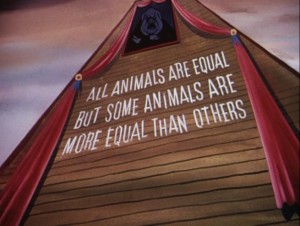
The papal election of Francis, not John Paul III or Benedict XVII, has brought an immediate cultural change. The pomp and pageantry–the red shoes, the billowing magenta capes–are being replaced by a renewed emphasis on social justice for the poor, mercy and humility. Taking a cue from their new boss, some cardinals have already started to dress down.
If he hasn’t already, the new pope will soon have a crack at the secret 300-page dossier delivered to Pope Benedict on December 17, 2013. Benedict had appointed three cardinals–Julian Herranz, Joseph Tomko and Salvatore De Georgi to investigate the leak of confidential Vatican documents in the scandal known as “Vatileaks Affair.”
Some claim this report pushed Pope Benedict into resigning. It may have been the last straw, if he admitted to himself he was too old, too frail and too entrenched to deal with the mess and scandal it described. The report was sealed, and put in a safe for his successor.
A story in the Italian newspaper, La Repubblica, claimed according to the report one fraction within the Vatican bureaucracy was “united by sexual orientation.” These powerful men formed a network of alliances, controlled careers, and were subject to blackmail over their sexual activities by the Mafia and other organized crime groups.
The threat of exposure has to be one key reason why the Vatican Bank never cleaned up. There are too many compromised individuals in the Vatican bureaucracy and elsewhere who would be ruined if their secret homosexuality or financial dealings came to light. Other corrupt members of the Curia, not homosexual, may have been happy to trade favors for friends, family and potential political allies.
What will happen if the pope decides to put the Vatican’s money in a commercial bank, and close down the Institute for Works of Religion?
I bet a few surprise names will join Cardinal Keith O’Brien in the news. 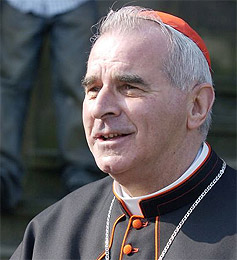
Cardinal O’Brien, who had a reputation for being anti-gay, was outed by his boyfriend and some seminarians he had sexually pressured just prior to the papal conclave. In the past, Cardinal O’Brien has referred to homosexuality as a “moral degradation.” He also labeled gay marriage as a “grotesque subversion of a universally accepted human right” and that same-sex partnerships were “harmful to the physical, mental and spiritual well-being of those involved.”
What was Cardinal O’Brien thinking when he was coming on to or in bed with another man?… That whatever strictures are out there didn’t apply to him.
A statue of the Pope John Paul II is under attack for its purported resemblance to Italian dictator Benito Mussolini. “How could they have given such a kind pope the head of a Fascist,” asked one distraught observer. 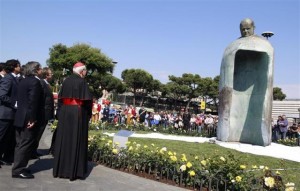
The 15-foot bronze statue by Roman artist Oliviero Rainaldi, was unveiled May 18, 2011 on what would have been John Paul’s 91st birthday. The statue is displayed outside Rome’s Termini train station.
The Fondazione Silvana Paolini Angelucci, a charitable organization, donated the sculpture to the city to celebrate the beatification of John Paul II. Mr. Rainaldi, the artist, was chosen because he had worked on several ecclesiastical commissions, and the foundation was confident that he could interpret the pope’s spirit. It was designed for the square in front of Termini, Rome’s main train station, which was dedicated to the pope in 2006, a year after his death.
While the statue is hardly as inflammatory as “La Nona Ora”–Maurizio Cattelan’s 1999 sculpture of Pope John Paul II getting hit by a meteor–some people are steadfast in their criticism of Rainaldi’s new artwork, with one Roman cleaning woman pointing out that the sculpture raised practical concerns as well as artistic ones. “With the shape of the cape, sooner or later the homeless people at the station will sleep inside it, and in no time it will be full of bottles of beer,” she said.
“A giant cow bell,” noted one critic referring to its cylindrical shape. “Mussolini,” said others noting the big bald head perched on top of the work, much like that of the fascist leader of Italy in the early 20th century. A few history buffs seemed to see the features of the Emperor Vespasian, the first-century sponsor of the Colosseum. Vespasian persecuted Christians as subversive to the state, and martyred a few at the Colosseum, mostly by hungry lions. A few were shot full of arrows.
But the most scathing review came from the Vatican’s official newspaper, Osservatore Romano. “The statue’s sin
“You know, in Italy everyone thinks they’re the coach of the national soccer team. Now, we have a nation of 66 million art critics,” said Umberto Broccoli, head of the city’s Cultural Heritage Department. “We were happy to accept a statue that cost the city zilch.”
For now, Mr. Rainaldi is taking the criticism in stride. “Usually, I get more compliments,” he said in a telephone interview. “Otherwise, I wouldn’t have survived in this business for 40 years; they would have stopped me earlier.”
The sculpture, he added, was never meant to be representational, though he was inspired by a photo of John Paul II enveloping a child in his cloak during a public audience many years ago. 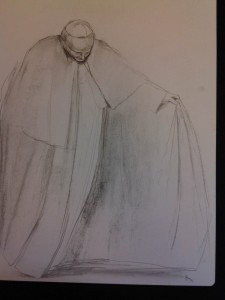
“That gesture seemed to me to be representative of the entire spirit of his pontificate: the meeting of cultures, the idea of dialogue, of offering a hand,” he said. “And if that hand is wrapped in a cloak, it takes on ulterior symbolism, like shelter and protection, an embrace towards and of people.”
Francesco Buranelli, secretary of the Vatican Fine Arts Commission, said the debate should not be reduced to a question of liking or not liking the statue. Contemporary art, regardless of when it was created, “shouldn’t be judged by subjective parameters,” he said. By that measure, he added, an infinite number of works now considered to be masterpieces, like Michelangelo’s “Last Judgement” or Caravaggio’s “Virgin of the Pilgrims,” would have been whitewashed or destroyed.
Via blog sites, a few of the faithful have weighed in on the statue. Here are a few representative comments:
– “Ah! A statue worthy of his pontificate.”
– “This almost makes me want to become a Protestant.”
– “Are they trying to say he was an empty shell of a man? Perhaps they are saying that he was full of hot air?”
-“Please tell us this was a joke; either it is a refrigerator with the door opened or a busted portable toilette, with a disembodied head perched atop. Sad. Or maybe I just do not appreciate “art.”
-“I find the enormous scale of the statue unseemly, to be honest. It reminds me more of Mussolini than it does John Paul II; it has that sort of bleak, intimidating fascist quality about it. I understand the artist’s need to express, somehow, this man’s enormity in history, and this statue certainly does that, but it doesn’t seem to also express anything about the subject that caused the world to love him: the pope’s warmth, humour, compassion, piety, and so on.”
-“If someone said Pope John Paul II liked chocolate, there’d be some bitter fruit here chiming in, trying to make a link, any link, on how he was a bad pope and responsible for every bad thing in the Church today.”
A landmark shift in the Catholic church’s hardline position on the use of condoms was published on November 23, 2010.
The pontiff makes the condom comments in a book-length interview with a German journalist, Peter Seewald, in “Light of the World: The Pope, the Church and the Signs of the Times.” In the interview, which took place in July 2010, the pope made clear that he didn’t consider condom use a “moral solution” to fighting the spread of infection, citing statements that put abstinence first. 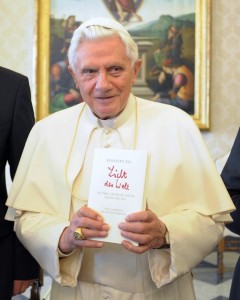
But, the pope added: “There may be a basis in the case of some individuals, as perhaps when a male prostitute uses a condom, where this can be a first step in the direction of a moralization, a first assumption of responsibility, on the way toward recovering an awareness that not everything is allowed and that one cannot do whatever one wants.”
In his statement on condom use the Pope Benedict infused morality with common sense–use protection to prevent the spread of the disease. Protecting your partner from a deadly and fatal disease is more important than the notion of being “open to life” during the sex act.
Benedict’s statement will save lives, prevent suffering, and help to make the Church relevant in Africa, Europe and North America; where for too long fantastical church statements took priority over the lived experience–and common sense–of ordinary Catholics.
Vatican spokesman Rev. Federico Lombardi told a news conference on November 23, 2010 that he conveyed the media’s “perplexity” directly to the pope, asking whether or not it made a difference if the prostitute in question was male or female. He said the pope said his reasoning applied to both sexes.
“The point is to take a step towards responsibility, to take into consideration the risk of the life of the person with whom you have relations whether it’s a man, woman or transsexual,” Father Lombardi said.
Pope Benedict’s decision to articulate his views on condoms to a journalist, rather than formulating a doctrinal document, may be an unusual attempt to stir debate. But it was also a way for the Pope to speak directly to Catholics, health care professionals, and media with his comments being subject to “interpretation” from the Curia and their conservative Catholic allies.
As early as 1988 then Cardinal Ratzinger tried to speed up the process to get rid of sexually abusive and pedophile priests. Ratzinger complained that church law made it exceedingly difficult to remove abusers if they didn’t request to be laicized voluntarily. He asked to get around the problem by finding “a quicker and simpler procedure” than a cumbersome church trial. He was turned down on the grounds that the priests’ ability to defend themselves would be compromised.
Given that, and the ensuing holocaust of sexual abuse revelations he has had to deal with as pope, I am not at all surprised by Pope Benedict’s decision to speak to a journalist rather than formulating a doctrinal document. The pope made “only small corrections” to the text, Mr. Seewald writes in a preface to the book.
Though Pope Benedict did not endorse the general use of condoms, or change official church teaching –which still strongly opposes contraceptives — his words ricocheted around the globe, greeted with anger and dismay from some conservative Catholics and enthusiasm from clerics and health workers in Africa, where the AIDS problem is the worst.
“We’re in a new world,” said the Rev. Jon Fuller, a Jesuit priest and a physician at the Center for H.I.V/AIDS Care and Research at Boston Medical Center. The pope is “implicitly” saying, he said, “that you cannot anymore raise the objection that any use of the condom is an intrinsic evil.”
It took the pope to say what he did to change the debate on the issue of condoms. In 1987, the U.S. bishops’ conference issued the statement, “The Many Faces of AIDS,” that stressed limiting sex to marriage as the best protection against the virus, but said public education “could include accurate information about prophylactic devices” to prevent transmission. The document was criticized at the time by conservatives and some Vatican officials.
Catholic conservatives who believed Catholic teaching against contraception to be inviolable were reeling over Pope Benedict’s remarks. “This is really shaking things up big time,” said Dr. John M. Haas, the president of the National Catholic Bioethics Center in Philadelphia, who serves on the governing council of the Vatican’s Pontifical Academy for Life.
Dr. Haas, a moral theologian, said he had seen an embargoed copy of a new book in which the pope conceded there might be extreme cases in which there were grounds for the use of condoms. “I told the publisher, ‘Don’t publish this: it’s going to create such a mess,'”he added.
The president of “Les Femmes – The Women of Truth,”an independent media apostolate of orthodox Roman Catholic laity in the Diocese of Arlington, VA weighed in on the pope’s condom kerfuffle: “Certainly, a gay prostitute is not using a condom for birth control so that is simply irrelevant,” she said. “On the other hand, homosexual sex is unnatural, degrading, and morally sinful. Can using a condom out of concern for transmitting AIDS make it less sinful? I think I understand the point that it might signal an awakening sense in the sinner of concern for the partner in sin; but what kind of concern is it when one is in the act of buggery? What times we live in! I’d rather debate how many angels can dance on the head of a pin. At least the thought of dancing angels in lovely.”
Lisa Sowle Cahill, a professor of theology at Boston College, said the pope’s new openness about condoms was significant even if it did not change church teaching. “I see it as a shift in attention, so that the politics of AIDS is larger on the radar screen than the politics of contraception, and to me that is a needed and appropriate shift,” she said. She added that the church had held firm against the use of condoms even to prevent AIDS because the birth control issue took so much precedence politically.
Dr. Haas could barely contenance Father Lombardi’s comments that broadened the debate to include women. “I don’t think it’s a clarification; it’s a muddying of the waters,” he said. “My opinion is that the pope purposely chose a male prostitute to avoid that particular debate.” And if Benedict was in fact opening that debate? – “I think the pope’s wrong,” Dr. Haas flatly stated.
“This is a game-changer,” declared the Rev. James Martin, a prominent Jesuit writer and editor. “By acknowledging that condoms help to prevent the spread of HIV between people in sexual relationships, the Pope completely changed the Catholic discussion on condoms,” Martin said.
Jesuit Father Federico Lombardi said he asked Pope Benedict why he agreed to the Seewald interview. The pope’s answer was that “obviously it wasn’t just to respond to Seewald’s questions, but because he thought that speaking to people today in a language that was simple, colloquial, on many questions that people pose would be a service he could render.”
“There is a type of magisterium found in official documents that are written, studied and rewritten; there is the magisterium in the homilies and catechesis of the pope; and then there is the communication of Pope Benedict in a colloquial, direct way” found in “Light of the World,” Father Lombardi said.



















